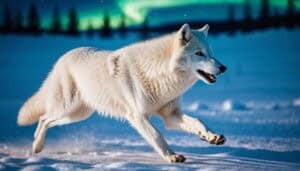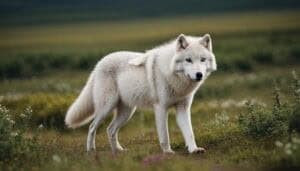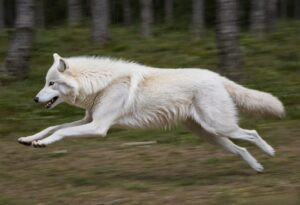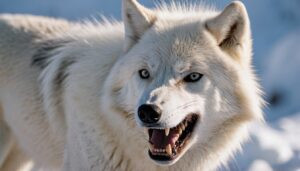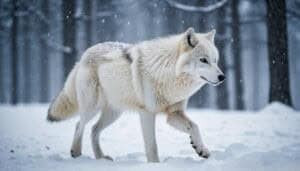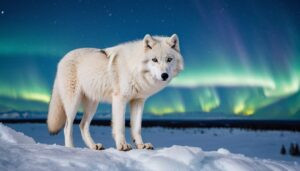Introduction
The skeletal structure of Arctic wolves is a fascinating subject that reveals much about their adaptability and survival in harsh environments. In this article, we will explore the total number of bones in an Arctic wolf’s body, compare it to other wolf species, and delve into the major bones that make up their structure
We will also examine how these bones are adapted to cold climates, the development of bones from birth to adulthood, and common skeletal issues. Finally, we will discuss the significance of studying the skeletal structure of Arctic wolves for wildlife biology and conservation efforts
Understanding the Bone Structure of Arctic Wolves
Arctic wolves, a subspecies of the gray wolf, are well-adapted to their cold, harsh environment. Their skeletal structure plays a crucial role in their survival, providing support, protection, and enabling efficient movement
Let’s explore the total bone count in an Arctic wolf and compare it to other wolf species
Total Bone Count in Arctic Wolves
Arctic wolves have a total of 321 bones in their body. This count includes all the bones in the skull, spine, ribs, limbs, and paws. Like other canids, their skeletal structure is designed for endurance, speed, and agility, allowing them to hunt and navigate the challenging terrain of the Arctic
Comparison with Other Wolf Species
When comparing the bone structure of Arctic wolves to other wolf species, such as the gray wolf and the red wolf, we find several similarities and a few differences. All wolves share a similar skeletal framework, with minor variations adapted to their specific environments
For example, the Arctic wolf’s bones are slightly more robust, providing extra strength and support for navigating snow and ice. In contrast, wolves from temperate regions might have more elongated limb bones, aiding in swift movement across open terrain
Arctic wolves also have larger paws compared to other wolf species, which act like natural snowshoes, distributing their weight more evenly and preventing them from sinking into the snow. This adaptation is crucial for their survival in the Arctic, where deep snow can be a significant obstacle
The differences in bone structure among wolf species highlight the remarkable adaptability of these animals. Each subspecies has evolved specific traits that enhance their ability to thrive in their respective habitats, showcasing the incredible diversity within the Canidae family
Major Bones in an Arctic Wolf’s Body
The skeletal structure of an Arctic wolf is composed of several major bones that are essential for its survival and function. These bones include the skull and teeth, spine and ribs, and limbs and paws. Each of these components plays a critical role in the wolf’s ability to hunt, move, and thrive in its environment
Skull and Teeth
The skull of an Arctic wolf is robust and well-adapted to its predatory lifestyle. It houses the brain and provides attachment points for the powerful muscles that control jaw movement. The skull also includes the mandible (lower jaw) and maxilla (upper jaw), which are equipped with sharp teeth
Arctic wolves have 42 teeth, including incisors, canines, premolars, and molars. The canines are particularly large and strong, designed for gripping and tearing flesh. The molars and premolars have sharp edges for slicing through meat and crushing bones
This dental structure is crucial for their diet, which primarily consists of large prey such as caribou and muskoxen
Spine and Ribs
The spine of an Arctic wolf is composed of several regions: cervical (neck), thoracic (chest), lumbar (lower back), sacral (pelvic), and caudal (tail) vertebrae. This structure provides flexibility and support, enabling the wolf to move with agility and speed
The cervical vertebrae support the head and allow for a wide range of motion, which is essential for hunting and scanning the environment
The thoracic vertebrae are connected to the ribs, forming the ribcage, which protects vital organs such as the heart and lungs. The ribcage also provides a strong framework that supports the respiratory system, allowing the wolf to take deep breaths during intense physical activity
Limbs and Paws
The limbs of an Arctic wolf are long and strong, designed for endurance and speed. The forelimbs consist of the scapula (shoulder blade), humerus (upper arm), radius and ulna (forearm), and the bones of the paws. The hind limbs include the femur (thigh), tibia and fibula (lower leg), and the bones of the paws
Arctic wolves have large, sturdy paws with thick pads and strong claws. These adaptations are essential for traction on icy surfaces and for digging through snow to find prey. The bones in their paws are arranged in a way that provides both stability and flexibility, enabling them to run efficiently across uneven terrain
Adaptations of Arctic Wolf Bones to Cold Environments
Arctic wolves are highly specialized animals that have evolved unique adaptations in their skeletal structure to survive the extreme conditions of their icy habitat. These adaptations provide them with the necessary tools to endure the cold, hunt efficiently, and move gracefully across the snowy landscape
Structural Adaptations
One of the key structural adaptations of Arctic wolf bones is their density and robustness. The bones of Arctic wolves are generally thicker and more robust compared to those of wolves living in milder climates
This increased bone density provides additional strength and support, which is crucial for traversing the rugged and often unstable terrain of the Arctic
The large, wide paws of Arctic wolves are another significant adaptation. The bones in their paws are specially designed to distribute the wolf’s weight more evenly, acting like natural snowshoes
This prevents the wolves from sinking into deep snow, allowing them to move more efficiently and conserve energy. The metacarpal and metatarsal bones in the paws are longer and wider, enhancing their ability to spread their weight
Arctic wolves also have a shorter, more compact body compared to other wolf species. This body structure helps reduce heat loss, which is vital in the frigid Arctic temperatures. The shorter extremities, including the legs and ears, minimize the surface area exposed to the cold, thereby conserving body heat
Functional Adaptations
The functional adaptations of Arctic wolf bones are equally impressive. These wolves have powerful jawbones and strong teeth, adapted for a diet that primarily consists of large prey
The robust mandible and maxilla bones provide the necessary leverage for powerful bites, enabling them to take down and consume animals like caribou and muskoxen
The articulation between the bones in their limbs is another crucial adaptation. The joints are designed to allow for a wide range of motion and flexibility, which is essential for hunting and navigating the challenging Arctic terrain
The ball-and-socket joints in the shoulders and hips provide rotational movement, while the hinge joints in the knees and elbows allow for powerful strides
The vertebral column of Arctic wolves is also adapted for endurance. The intervertebral discs are thick and cushiony, providing shock absorption during running and jumping. This adaptation helps prevent injuries and supports the wolves’ need to travel long distances in search of food
Development and Issues of Arctic Wolf Bones
The development of bones in Arctic wolves from birth to adulthood is a fascinating process that involves growth, maturation, and adaptation. Understanding this development provides insights into their lifecycle, health, and common skeletal issues they may encounter
Bone Development from Birth to Adulthood
Arctic wolf pups are born with a relatively undeveloped skeletal system. At birth, their bones are softer and more pliable, primarily composed of cartilage. This flexibility is crucial during the birthing process and early life stages, allowing the pups to grow rapidly without the constraints of rigid bones
As the pups grow, a process called ossification occurs, where the cartilage gradually turns into bone. This process is driven by the deposition of minerals, particularly calcium and phosphorus, which harden the bone structure
By the time Arctic wolves reach adulthood, their bones have fully ossified, providing the necessary strength and support for their active lifestyle
During the first few months of life, the growth plates in the long bones (such as the femur and humerus) play a significant role in bone development. These growth plates, located at the ends of the bones, are areas of rapid cell division, contributing to the elongation of the bones
Proper nutrition, especially a diet rich in minerals and vitamins, is essential during this stage to ensure healthy bone development
Common Skeletal Issues
Despite their robust skeletal structure, Arctic wolves can suffer from various skeletal issues, some of which are common to many canids, while others are more specific to their harsh environment:
1. Fractures and Bone Injuries: Arctic wolves are highly active and often engage in rigorous physical activities such as hunting and fighting. This can sometimes lead to fractures and other bone injuries
Given the harsh and unforgiving terrain they navigate, these injuries can be more frequent compared to wolves in less extreme environments
2. Arthritis and Joint Issues: As Arctic wolves age, they can develop arthritis, a condition characterized by inflammation of the joints. This condition can cause pain and stiffness, particularly in the hips, knees, and shoulders
The wear and tear on their joints from years of running and hunting can exacerbate this condition, affecting their mobility and overall quality of life
3. Nutritional Deficiencies: In the wild, Arctic wolves rely on their prey for essential nutrients. However, fluctuations in prey availability can lead to periods of nutritional deficiencies, particularly of calcium and phosphorus
These deficiencies can affect bone density and strength, making the wolves more susceptible to fractures and other skeletal issues
4. Congenital Disorders: While less common, some Arctic wolves may be born with congenital skeletal disorders. These can include malformations in the bone structure, which can impact their ability to move and hunt effectively
Such conditions often result in lower survival rates for affected individuals
Importance of Studying Arctic Wolf Skeletal Structure
The skeletal structure of Arctic wolves offers invaluable insights into their biology, behavior, and the broader ecological dynamics of their environment. Studying these bones provides important information for wildlife biology and conservation efforts, helping to ensure the survival of this remarkable species
Insights for Wildlife Biology
Understanding the skeletal structure of Arctic wolves allows biologists to gain a deeper understanding of their physical capabilities and adaptations. By examining the bones, scientists can infer the following:
1. Movement and Hunting Strategies: The robust and specialized bones of Arctic wolves reveal much about their movement patterns and hunting strategies
For instance, the structure of their limbs and paws indicates their ability to traverse snow and ice, while the strength of their jaws and teeth underscores their role as apex predators. By studying these bones, biologists can better understand how Arctic wolves hunt, capture, and consume their prey
2. Health and Nutrition: Bones can also provide clues about the health and nutritional status of Arctic wolves. Signs of malnutrition, disease, or injuries can be detected through careful examination of the bones
This information is crucial for assessing the overall well-being of wolf populations and identifying potential threats to their health
3. Evolutionary Adaptations: The unique adaptations of Arctic wolf bones to their environment shed light on the evolutionary processes that have shaped their development
Comparative studies with other wolf species and canids can highlight the specific adaptations that have enabled Arctic wolves to survive in such a harsh climate. This knowledge contributes to our broader understanding of evolutionary biology and species adaptation
Conservation Implications
Studying the skeletal structure of Arctic wolves has significant implications for conservation efforts. This research helps inform strategies to protect and manage these animals in the wild:
1. Population Monitoring: By analyzing skeletal remains, conservationists can gather data on population dynamics, including age distribution, mortality rates, and reproductive success
This information is vital for developing effective conservation plans and ensuring sustainable populations
2. Habitat Protection: Understanding the physical and ecological needs of Arctic wolves aids in identifying critical habitats that require protection
Conservation efforts can then focus on preserving these habitats, ensuring that wolves have access to the resources they need to thrive
3. Human-Wildlife Conflict Mitigation: Studying the behavior and movement patterns of Arctic wolves through their skeletal structure can help mitigate conflicts with human activities
For example, knowledge about their hunting ranges and migration routes can inform the development of measures to reduce encounters with humans and livestock
4. Climate Change Impact: Climate change poses a significant threat to Arctic ecosystems. By studying how Arctic wolves have historically adapted to environmental changes, scientists can predict how current and future climate shifts might affect them
This foresight is crucial for developing adaptive conservation strategies that can help Arctic wolves cope with changing conditions
Conclusion
The skeletal structure of Arctic wolves is a testament to their remarkable adaptability and survival in one of the harshest environments on Earth. Throughout this article, we explored various aspects of their bones, from the total bone count to specific structural and functional adaptations
We delved into the major bones, such as the skull, spine, and limbs, highlighting their unique features that support the wolves’ predatory and survival strategies
Understanding the bone development process from birth to adulthood provided insights into the growth and health challenges Arctic wolves face, including common skeletal issues like fractures and arthritis. Finally, we emphasized the importance of studying their skeletal structure for wildlife biology and conservation efforts
This knowledge not only deepens our appreciation of these magnificent creatures but also informs strategies to protect and sustain their populations in the face of environmental changes and human activities
By comprehensively examining the skeletal structure of Arctic wolves, we gain a richer understanding of their role in the Arctic ecosystem and the evolutionary marvels that have enabled their survival. This information is crucial for ensuring the continued existence of Arctic wolves and maintaining the delicate balance of their habitat


